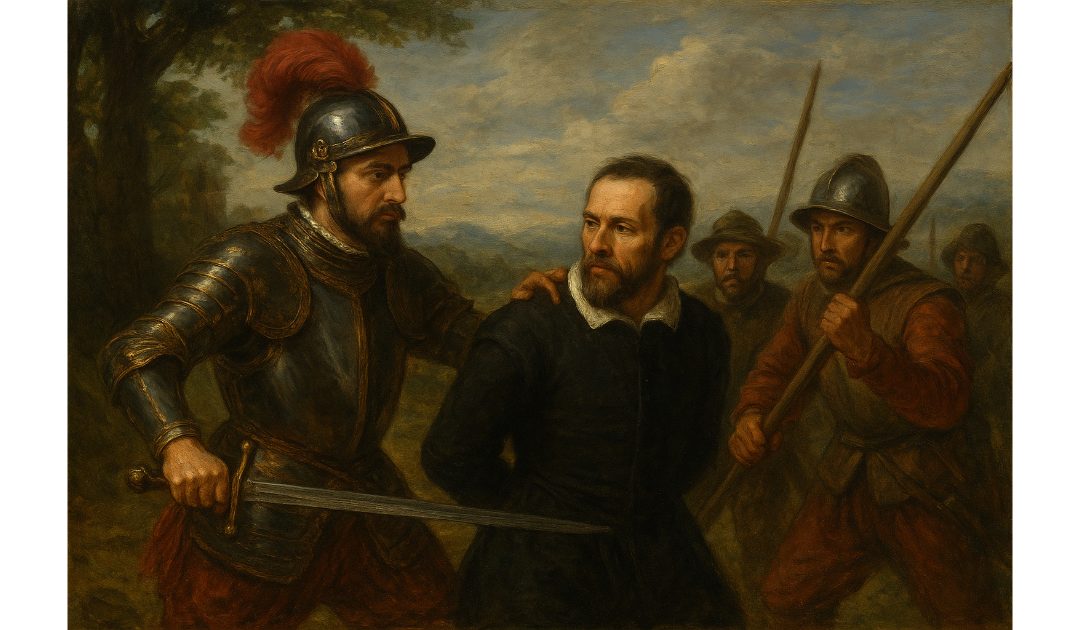On the 10th of October, 1575, Roman Catholic forces under Henry I, Duke of Guise, defeated the Protestants and captured, amongst others, Philippe de Mornay. There are several points at which the stories of Philippe de Mornay and my ancestor, Sir Anthony Standen intersect.
Philippe de Mornay, also known as Du Plessis-Mornay, was a prominent French Protestant writer, diplomat, and theologian. He was born on the 5th of November, 1549, in Buhy, a small commune in Normandy. Mornay played a significant role in the Huguenot movement during the late 16th and early 17th centuries. His contributions spanned theological discourse, political diplomacy, and literary achievement, shaping both religious and political landscapes of his time.
Hailing from a noble family, Mornay’s father, Jean de Mornay, was a fervent Catholic. However, after his father’s death, Mornay’s mother influenced his conversion to Protestantism. His extensive and thorough education, which included theology, law, and languages, was pursued at the University of Heidelberg and later at the University of Padua. These academic endeavours not only honed his intellectual capabilities but also deepened his commitment to Reformed theology.
Claire and I recently visited the University of Padua. It was inspiring to see Galileo’s desk and stand in the room where he lectured. A portrait of Francis Walsingham hangs on the wall, he was also a student at Padua. Walsingham was Sir Anthony Standen’s spymaster, and Galileo is a character in Fire and Earth, the second book in the Sir Anthony Standen Adventures.
In the volatile atmosphere of the French Wars of Religion, Mornay emerged as an influential advocate for the Huguenot cause. His diplomatic acumen was first recognised during his service under Admiral Gaspard de Coligny, a leading Huguenot statesman. However, the St. Bartholomew’s Day Massacre of 1572, which resulted in the brutal killing of thousands of Huguenots, marked a pivotal turn in Mornay’s life. He narrowly escaped this tragedy, an experience that fortified his resolve to defend the Protestant faith both through the pen and the sword.
Mornay’s political career was intrinsically linked to Henry of Navarre, who later became King Henry IV of France. As a close advisor and diplomat to Henry, Mornay played a pivotal role in negotiating alliances with Protestant powers across Europe. His diplomatic missions took him to England, the Netherlands, and Germany, where he sought support against Catholic forces. Mornay was instrumental in the formulation of the Edict of Nantes in 1598, which granted substantial rights to Huguenots. However, he was often critical of Henry IV’s decision to convert to Catholicism to consolidate his rule.
Perhaps Mornay’s most enduring legacy lies in his literary and theological works. He was a prolific writer whose works addressed both doctrinal issues and political theory. His treatise, “De l’institution, usage et doctrine du saint sacrement dans l’église ancienne” (Institution, Use, and Doctrine of the Holy Sacrament in the Ancient Church), published in 1598, was a seminal work challenging Catholic Eucharistic doctrine. This work led to his famous public disputation in 1600 with Cardinal Jacques Davy du Perron, a debate that showcased Mornay’s formidable theological prowess despite his declining health.
Mornay’s writings often reflected his deep commitment to religious tolerance and governance grounded in moral and ethical considerations. His “Vindiciae contra tyrannos” (A Defence of Liberty Against Tyrants), published anonymously in 1579, is speculated to have been authored by him. This radical work argued for the right of resistance against oppressive rulers, laying intellectual groundwork that influenced later Enlightenment thinkers regarding governance and civil liberties.
Despite his close association with Henry IV, Mornay’s relationship with the king grew strained over time due to their divergent views on religion. Henry’s pragmatic shift towards Catholicism and Mornay’s unwavering Protestant convictions created a rift, leading Mornay to withdraw from court life. He retreated to Saumur, where he served as the governor and established the Academy of Saumur, a Reformed Protestant institution that became a centre of theological learning and discourse.
Mornay’s personal life was marked by his steadfast faith and dedication to his family. He married Charlotte Arbaleste, a fellow Huguenot, whose memoirs provide intimate insights into their life together, their shared faith, and the trials they faced during a period fraught with religious conflict.
Philippe de Mornay passed away on the 11th of November, 1623, in Saumur. His death marked the end of an era for the Huguenot movement, but his influence continued through his writings and the institutions he helped establish. His legacy is that of a man who navigated the turbulent waters of religious war, political intrigue, and theological debate with unwavering integrity and intellectual vigour.
Mornay’s life epitomises the complexities of the Reformation era, where faith, politics, and personal conviction intertwined. His contributions to Protestant theology, defence of religious liberty, and diplomatic efforts showcase his pivotal role in shaping early modern Europe. Beyond his theological and diplomatic achievements, Mornay’s story is one of a man whose principles guided him through one of France’s most tumultuous periods.

